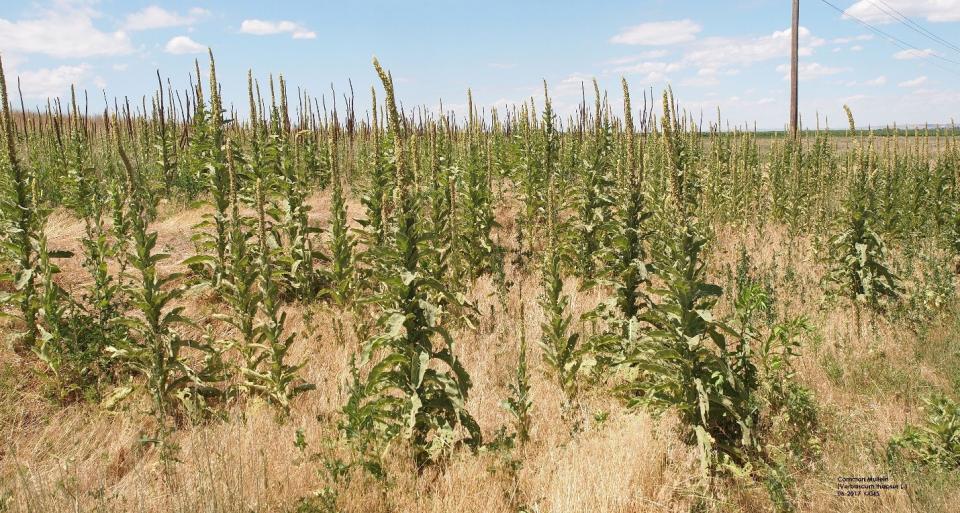
Common Mullein, an Invasive Weed on Nebraska’s Horizon
Early Detection and Rapid Response (EDRR) is a concept to identify potentially invasive species prior to or just at their establishment. Developing an Integrated Pest Management plan (IPM) to manage, contain, and eradicate the invasive species before it spreads can help avoid costly, long-term control efforts.
One such invasive species that could affect western Nebraska is common mullein, an herbaceous biennial forb found throughout the Great Plains and most of North America. It is a county or state noxious weed in Nebraska, Colorado, and Wyoming.
Common mullein is also known as Jacob’s staff, flannel leaf, velvet plant, velvet dock, or flannel plant. Originally from Europe, it was first reported in North America in the mid-1700s as an ornamental, a medicinal herb, and used as a piscicide, a chemical substance poisonous to fish.
Common mullein reproduces and spreads by seeds. It is a prolific seed producer; large mature plants can produce up to 240,000 seeds per year that remain viable in the soil for more than 100 years. Seeds germinate in fall and form a basal rosette. During the second year of growth, the plants “bolt” and produce a flower stalk. Seed can be spread by wildlife, vehicles, construction equipment, livestock, forages, feed grains, soil, and gravel.
Common mullein has an extensive fibrous and tap root system. The root system allows the plant to access soil moisture better than native plants, giving it a competitive advantage, especially during dry years.
Rosettes can be over 2 feet across. An individual rosette leaf can be over one foot long and covered with dense hairs, giving it the feel of velvet. The flower stalk can be 2 to 8 feet tall. Leaves are alternate and progressively smaller to the base of the seed head.
Flowering usually occurs in June and July when single flower stalks packed with sulfur-yellow colored flowers bolt. The flowers are five-lobed and united at the base. Seed capsules are woolly and contain numerous small seeds.
Habitat
Common mullein is adaptive to a wide range of environmental conditions, favoring disturbed sites. It is often found in rangeland, pastures, waste areas, roadsides and woodlands. It has no forage value for livestock and can reduce grass production.


Management
Prevention is the best and cheapest management option. Having well-established grasses and forbs on a maintained pasture or rangeland with proper grazing and rotational grazing techniques can go a long way to prevent its establishment. Detecting infestations early through scouting, monitoring, and proper identification are key management factors given how quickly it infests and spreads.
To manage common mullein and promote your desired plant community create an Integrated Pest Management plan (IPM) combining multiple control strategies.
- Mechanical Control. Pulling or cultivating small common mullein plants can be an effective control method, as long as the plants are young (before they go to seed). Mowing can be effective to reduce seed production but must be repeated throughout the season.
- Biological Control. Consider using biological control insects, such as the curculionid weevil (Gymnetron tetrum) and the mullein moth (Cucullia verbasci). The weevil larvae feed on the seed in the seed capsule and can destroy up to 50% of the seed. The moth larvae feed on the foliage. Biological control methods should be entered into only after full consideration of potential non-target species impacts. Other management methods must be used in combination to reduce and control the infestation.
- Chemical Control. Consider the site, overall weed complex, forbs, shrubs, and trees when selecting a herbicide. Consult the specific herbicide label for recommendations or requirements on the timing of application, amount of water carrier, and herbicide rate and carefully follow all label directions.
The dense hairy leaves of common mullein can affect herbicide coverage and uptake and cause erratic control. When the herbicide label allows, use of a crop oil concentrate (COC), methylated seed oil (MSO), or other oil-based adjuvant may improve herbicide penetration through the hairy leaf surface, although grass injury may occur. Generally, treatment should occur during the spring rosette to early bud/bolt stage. Retreatment of areas infested with common mullein may be needed due to the long life of the seeds.
| Herbicide (Active Ingredient) | Rate | Mode of Action Group |
|---|---|---|
| Chaparral (aminopyralid + metsulfuron methyl) |
1-2 dry ounces/acre | Groups 2 and 4 |
| Milestone (aminopyralid) |
7 fluid ounces/acre | Group 4 |
| Escort XP (metsulfuron methyl) |
1-2 dry ounces/acre | Group 2 |
| Telar XP (chlorsulfuron) |
1-2.6 dry ounces/acre | Group 2 |
| Graslan L (picloram + 2,4-D) |
3-4 pints/acre | Group 4 |
| Glyphosate (Accord, Cornerstone, Roundup) |
3-5 quarts per acre, depending on formulation | Group 9 |
| Cimarron Plus (chlorsulfuron + metsulfuron methyl) |
0.625-1.25 dry ounces per acre | Group 2 |
| GrazonNext HL (aminopyralid + 2,4-D) |
24-34 fluid ounces per acre | Group 4 |
| Mention of a specific herbicide product does not constitute an endorsement of any specific brand. | ||
Herbicide Recommendations and Disclaimers
Herbicide group numbers refer to the product's mode of action in the plant. Using different modes of action can help reduce the chance of herbicide resistance evolving in the target weed species. (For more information, see the Take Action Herbicide Classification chart.)
Be sure to select a product labeled for the site. Read, understand and follow all label instructions when using any pesticide Pesticide labels and safety data sheets (SDS) can be found at https://www.cdms.net/.
References
“Common Mullein and Moth Mullein Identification and Management”, Weld County Public Works Department, Weed Division, Greely, Colorado
Klein, Helen, “Common Mullein”, Alaska Natural Heritage Program, University of Alaska, 2011
Common Mullein Fact Sheet, Plant Conservation Alliance’s Alien Plant Working Group, National Park Service
Online Master of Science in Agronomy
With a focus on industry applications and research, the online program is designed with maximum flexibility for today's working professionals.
